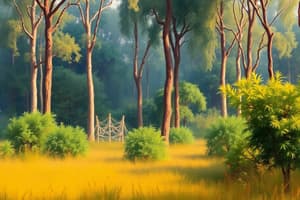Podcast
Questions and Answers
To which one of the following types of vegetation does rubber belong to?
To which one of the following types of vegetation does rubber belong to?
- Tundra
- Himalayan
- Tidal
- Tropical Evergreen (correct)
Cinchona trees are found in the areas of rainfall more than
Cinchona trees are found in the areas of rainfall more than
- 100 cm (correct)
- 70 cm
- less than 50 cm
- 50 cm
In which of the following state is the Simlipal bio-reserve located?
In which of the following state is the Simlipal bio-reserve located?
- Punjab
- West Bengal
- Delhi
- Odisha (correct)
Which one of the following bio-reserves of India is not included in the world network of bioreserve?
Which one of the following bio-reserves of India is not included in the world network of bioreserve?
What is a bio-reserve?
What is a bio-reserve?
Name two animals having habitat in tropical and montane type of vegetation.
Name two animals having habitat in tropical and montane type of vegetation.
Distinguish between Flora and Fauna
Distinguish between Flora and Fauna
Distinguish between Tropical Evergreen and Deciduous forests.
Distinguish between Tropical Evergreen and Deciduous forests.
Name different types of Vegetation found in India and describe the vegetation of high altitudes.
Name different types of Vegetation found in India and describe the vegetation of high altitudes.
Quite a few species of plants and animals are endangered in India. Why?
Quite a few species of plants and animals are endangered in India. Why?
Why has India a rich heritage of flora and fauna?
Why has India a rich heritage of flora and fauna?
Flashcards
Natural Vegetation
Natural Vegetation
A plant community that has grown naturally without human interference and remains undisturbed for a long time.
Endemic Vegetation
Endemic Vegetation
Vegetation that is purely native to a region and not introduced from elsewhere.
Exotic Plants
Exotic Plants
Plants that have been introduced to a region from other parts of the world.
Flora
Flora
Signup and view all the flashcards
Fauna
Fauna
Signup and view all the flashcards
Tropical Evergreen Forests
Tropical Evergreen Forests
Signup and view all the flashcards
Tropical Deciduous Forests
Tropical Deciduous Forests
Signup and view all the flashcards
Moist Deciduous Forests
Moist Deciduous Forests
Signup and view all the flashcards
Dry Deciduous Forests
Dry Deciduous Forests
Signup and view all the flashcards
Thorn Forests and Scrubs
Thorn Forests and Scrubs
Signup and view all the flashcards
Montane Forests
Montane Forests
Signup and view all the flashcards
Wet Temperate Forests
Wet Temperate Forests
Signup and view all the flashcards
Temperate Forests
Temperate Forests
Signup and view all the flashcards
Alpine Vegetation
Alpine Vegetation
Signup and view all the flashcards
Mangrove Forests
Mangrove Forests
Signup and view all the flashcards
Medicinal Plants
Medicinal Plants
Signup and view all the flashcards
Biosphere Reserve
Biosphere Reserve
Signup and view all the flashcards
Wildlife Protection Act of 1972
Wildlife Protection Act of 1972
Signup and view all the flashcards
Gir Forest
Gir Forest
Signup and view all the flashcards
Wildlife Sanctuaries
Wildlife Sanctuaries
Signup and view all the flashcards
Gharial
Gharial
Signup and view all the flashcards
Wetlands
Wetlands
Signup and view all the flashcards
Flamingo
Flamingo
Signup and view all the flashcards
Conservation
Conservation
Signup and view all the flashcards
Ecosystem
Ecosystem
Signup and view all the flashcards
Endangered Species
Endangered Species
Signup and view all the flashcards
Extinct Species
Extinct Species
Signup and view all the flashcards
Poaching
Poaching
Signup and view all the flashcards
Introduction of Alien Species
Introduction of Alien Species
Signup and view all the flashcards
Deforestation
Deforestation
Signup and view all the flashcards
Over-exploitation
Over-exploitation
Signup and view all the flashcards
Study Notes
Natural Vegetation and Wildlife in India
-
India is one of 12 mega biodiversity countries globally, ranking 10th in the world and 4th in Asia for plant diversity.
-
India has approximately 47,000 plant species, including 15,000 flowering plants (6% of the world's total).
-
Natural vegetation refers to plant communities that grow naturally without human intervention. Virgin vegetation is naturally occurring and undisturbed.
-
Endemic species are plants and animals unique to India, while exotic species are from other regions.
-
Flora refers to plants, and fauna refers to animals, of a particular region or time period.
-
Major vegetation types in India include:
- Tropical Evergreen Forests: Found in areas with heavy rainfall (over 200 cm), characterized by tall trees, lush vegetation, and no distinct leaf shedding season. Commercially important trees include ebony, mahogany, rosewood, rubber, and cinchona. Common animals include elephants, monkeys, lemurs, and deer.
- Tropical Deciduous Forests: The most widespread type, occurring in areas with rainfall between 200 cm and 70 cm. These forests have a dry season, where trees shed their leaves. Teak is a dominant species. Other important species include bamboos, sal, shisham, sandalwood, khair, kusum, arjun, and mulberry. Common animals found here include lions, tigers, pigs, deer, and elephants.
- Tropical Thorn Forests and Scrubs: These forests are found in areas with less than 70 cm of rainfall, and are characterized by thorny trees and bushes. Common plants include thorny trees and shrubs. Some animals are lions, tigers, pigs, deer, and elephants.
-
Montane Forests: Occur at higher altitudes with decreasing temperatures. Various tree types and animals are found in different altitude zones. Common examples could include pine, oak, rhododendron etc.
-
Mangrove Forests: Found in coastal areas influenced by tides, with salt-tolerant plant species (like mangroves). Common animals may include turtles, crocodiles, gharials, and snakes.
-
Medicinal plants: India is rich in medicinal plants, with approximately 2000 plants used in Ayurveda. Some commonly used plants include sarpagandha, jamun, Arjun, babool, neem, tulsi, and kachnar.
Wildlife in India
- India has a diverse range of wildlife, with around 90,000 animal species.
- Important animals include elephants, rhinoceroses, bison, nilgai, chousingha, and various deer species, as well as monkeys.
Conservation Efforts
- India's government has implemented various initiatives to protect flora and fauna, including establishing biosphere reserves and national parks.
- The country has 106 National Parks and 573 Wildlife Sanctuaries to preserve its natural heritage.
Studying That Suits You
Use AI to generate personalized quizzes and flashcards to suit your learning preferences.




